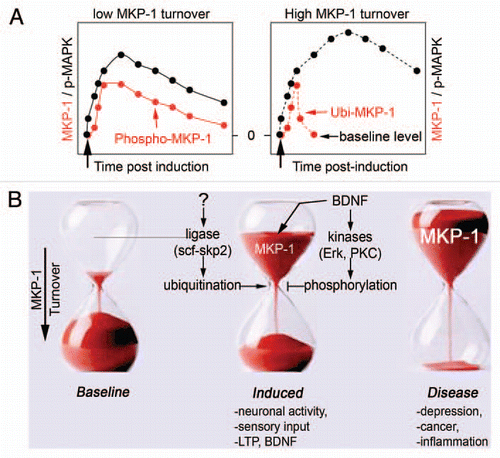Figures & data
Figure 1 Control of MKP-1 levels. (A) Baseline expression of MKP-1 is low, but highly inducible by sensory stimuli, neuronal activity and trophic factors such as BDNF. Once expressed, MKP-1 is unstable with a turnover <1 h. When phosphorylated by neuronal activity or BDNF, MKP-1 stability extends to >8 h.Citation1 As a consequence, MAPK signaling is shaped accordingly to MKP-1 levels. (B) The mechanisms that regulate MKP-1 levels involve protein kinases and ubiquitin ligases. Abnormal expression of MKP-1 is a hallmark of several disorders, such as stress and depression.Citation2

Figure 2 Titration of MKP-1 levels determines the physiological outcome. (A) Scheme summarizing the effects of MKP-1 on morphological plasticity. Loss of mkp-1 prevents activity-dependent and BDNF-induced morphological plasticity of the axon compared to wildtype controls. However, neuronal morphology is indistinguishable between the two genotypes under baseline conditions. Transient induction of MKP-1 mirrors the effects of BDNF and neuronal activity on axon branching, whereas prolonged expression prevents axon growth. (B) Ectopic expression of MKP-1 disrupts axonal growth at any stage of development. Length of the longest neurite per cell (mean ± SEM). Numbers in bars indicate the number of cells analyzed. ***p < 0.01, t test, n= 3 independent experiments. n.s., not significant.
